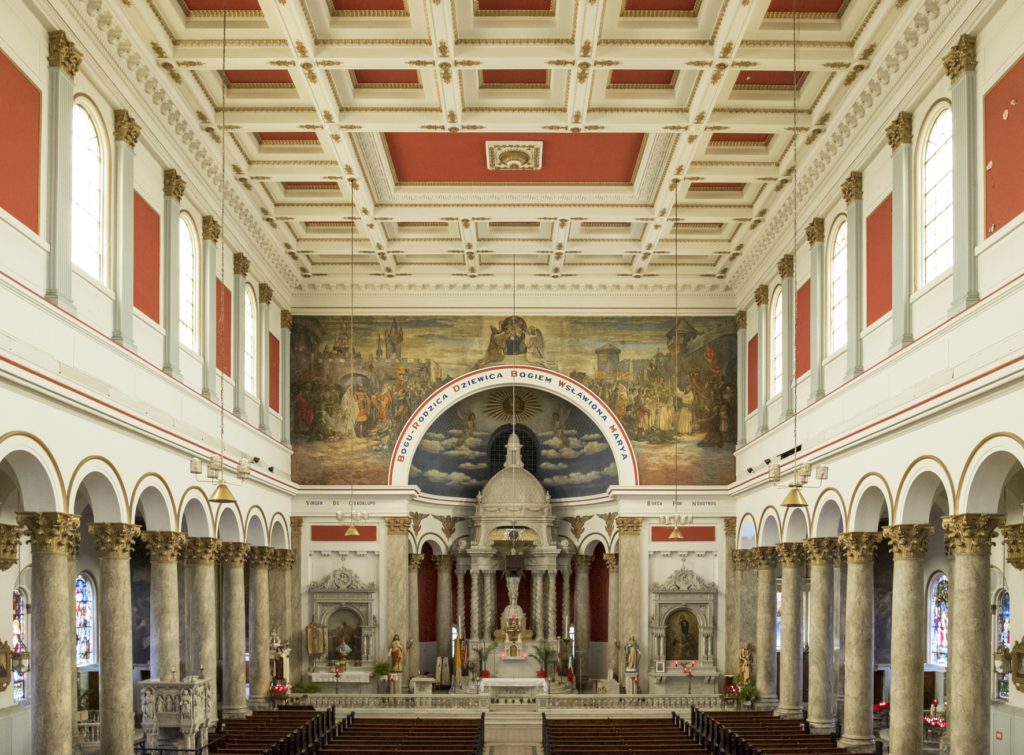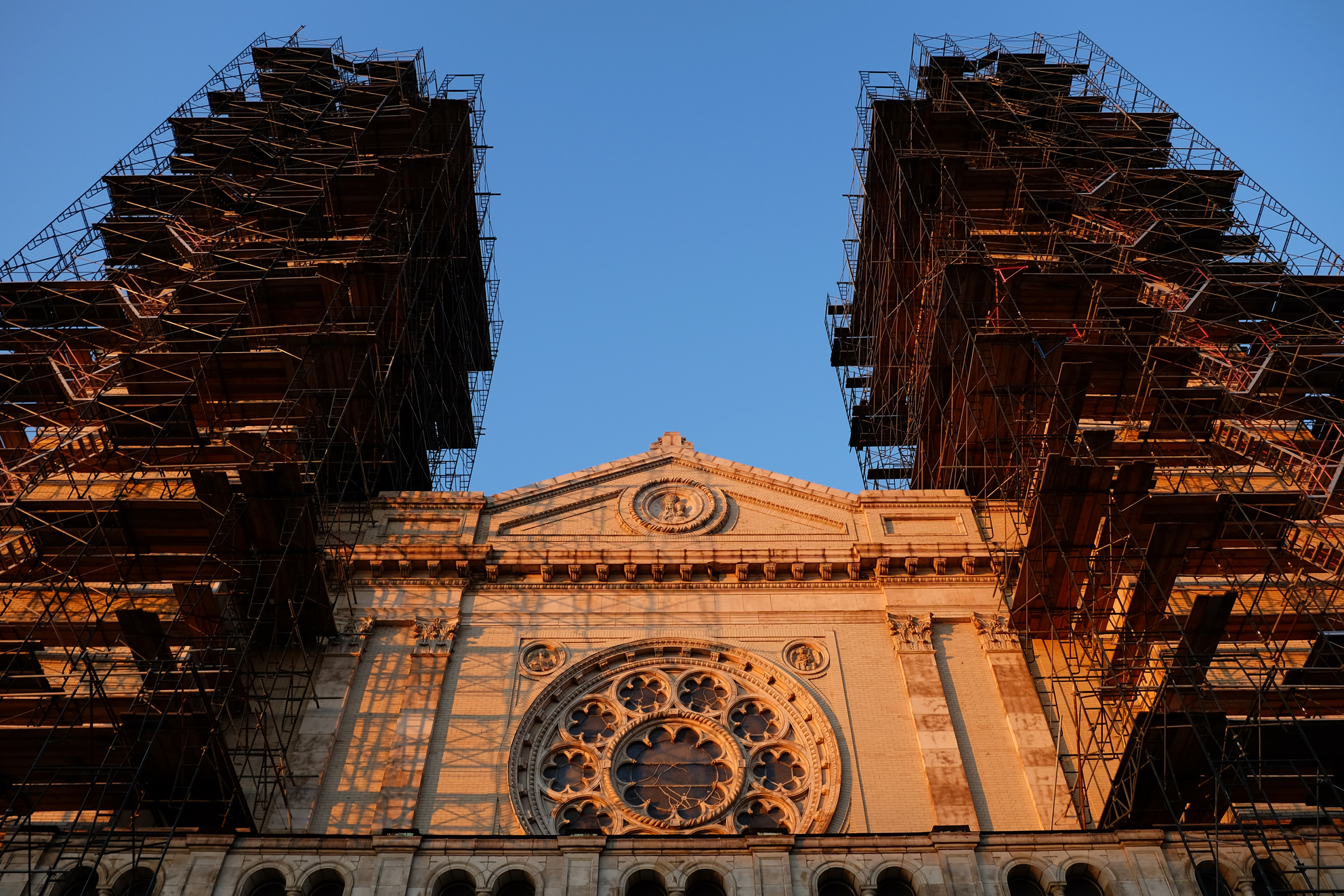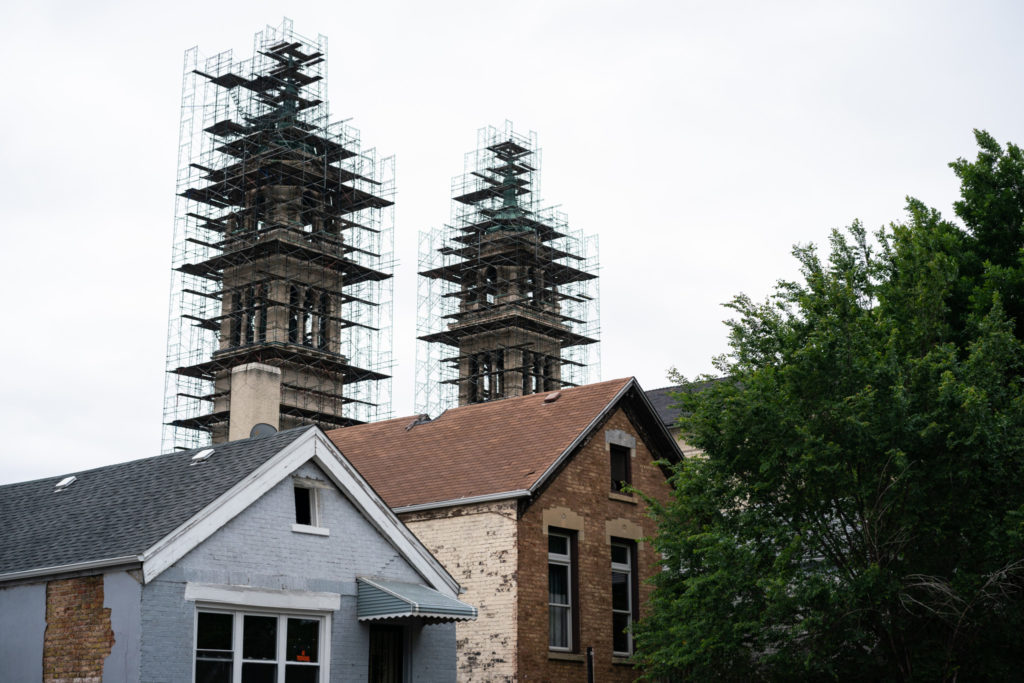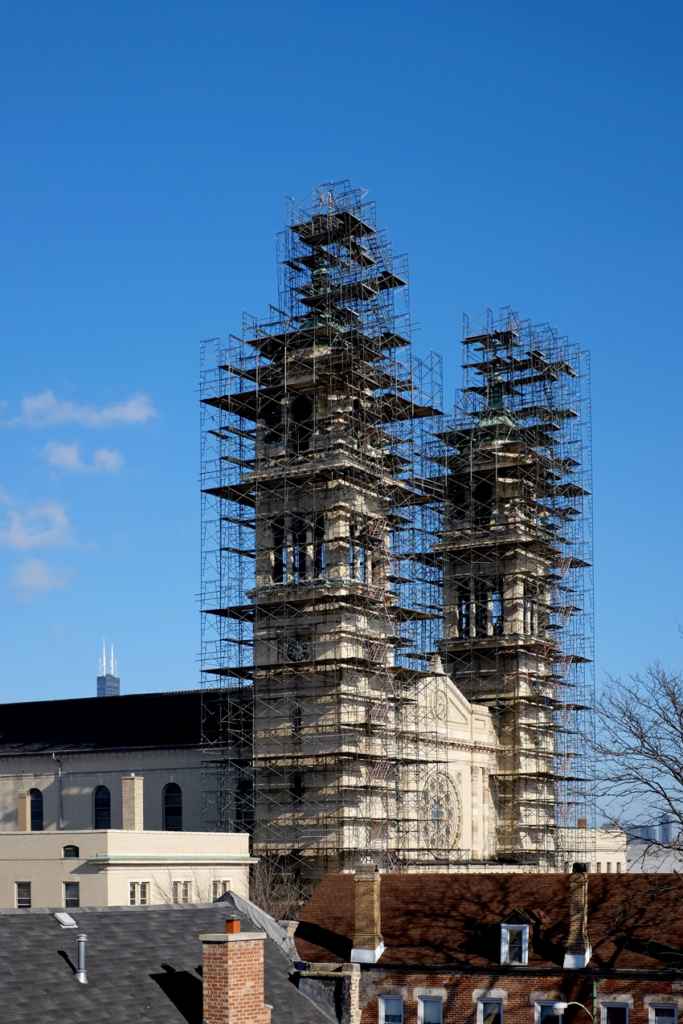As former parishioners of St. Adalbert wrestled with the Chicago Archdiocese over the fate of the shuttered Pilsen church, a developer jumped into the picture with a new proposal—and earlier this year, the City gave that project a financial leg up.
Nonprofit developer Metropolitan Housing Development Corporation is proposing a mixed-use project on the western edge of St. Adalbert’s campus, which includes the basilica, rectory, school and parking lot at 16th and Ashland. The proposed development would provide housing and supportive services to seventy-seven asylum seeker households. The first phase of the project is estimated to cost $28 million.
The project, Pilsen Migrant Continuum of Care Workforce Housing, was one of thirteen affordable housing developments that the Department of Housing (DOH) selected to receive federal tax credits in early March.
The majority of the proposed units would be studio or one-bedroom apartments in a new building, according to a copy of the funding application that the Weekly obtained through public records requests. Ten two-bedroom apartments would be built in the existing refectory.
In later phases, the developer would rehab the historic church and convent buildings to build out a “welcoming/resource center” and a shelter site. Local social service providers said that the project, as described, could be a first of its kind and was “exciting” to hear about as an approach to expanding housing access.
“I’m very happy and glad to see our leaders thinking about developing housing to help [asylum seekers],” said Johannes Favi, deputy director of the Illinois Community for Displaced Immigrants.
But a review of the project narrative, submitted in July 2023 as part of an application for low-income housing tax credits, raises questions about the developer’s ability to get the project off the ground. For one, the Archdiocese still owns the land, and has “no current agreement with any group,” a diocesean spokesperson told the Weekly by email.
Last August, one month after Metropolitan Housing submitted its application to the City for federal funding allocation, the Sun-Times reported that the land was under contract for sale to an out-of-state company. That sale ultimately fell through.
Details pertaining to operating costs, sustainable design, supportive services, and community engagement efforts appear to be vague or contradictory. A spokesperson for the DOH, which awarded $1.2 million in tax credits for the project’s first phase, declined to respond to questions about the project and the developer’s pending letter of intent to buy the property.
“At this point in time, we are refraining from commenting on any one project in particular as they still need to undergo the stage II review process,” a DOH spokesperson said by email. Neither Metropolitan Housing nor two other groups affiliated with the project responded to requests for comment.
Ald. Byron Sigcho-Lopez (25th Ward) said he is aware of the plan but has not yet received a copy of the full proposal. The development would first have to go through the ward’s established community engagement and review process to get his office’s support, he said.
The fate of the church, which the Archdiocese closed in 2019, citing low attendance, has been uncertain for years.
At a May 10 hearing, Sigcho-Lopez and dozens of community members and former parishioners urged the City to grant landmark status to protect the church buildings and their cultural legacy. In the little more than a century that the church was open, it served mainly Polish and then Mexican parishioners.
“I am here defending the right of our community to landmark a building for generations to come, for immigrants, no matter where they come from, to celebrate their heritage,” Sigcho-Lopez said at the hearing.
Metropolitan Housing drew upon the church’s rich immigrant history in its proposal to provide a “continuum of care” to newly arrived asylum seekers in Chicago. The church campus “has long been an area that is accepting of immigrants dating back to the turn of the century,” the nonprofit developer wrote in its July 2023 application to DOH.
The proposed complex would offer affordable housing and eventually some amount of supportive services, according to the application. Rents would range from $586 for a studio to $1,300 for a two-bedroom. Any asylum seeker applying for a unit would have to be employed to qualify.
Some of the plan’s details about supportive housing, sustainability, costs, and site acquisition remain murky. The development is to have four permanent supportive housing units. The developer did not specify how services would differ between those four units and other households that would be built in the complex.
In one part of the application, Metropolitan Housing indicated that a local, yet-to-be-named nonprofit would provide twice-a-week assistance with navigating public benefits and local resources, education and employment assistance, childcare, and community building activities.
But later in the application, the developer wrote that daycare would not be provided and that it was too soon to say definitively what services would be provided. In response to several other questions about plans for supportive services, the developer wrote, simply, “TBD” or “n/a” (not applicable).
The developer also wrote that it planned to meet “a high standard of sustainability” and would strive for LEED silver certification, but did not provide any detail about how it would approach sustainable design. The building’s utilities will be all gas, according to the application.
To finance the project, Metropolitan Housing asked the City for $1.2 million in low-income housing tax credits (LIHTC). Those credits are expected to generate $11,622,672 in equity for the development over the next ten years, and will ensure the housing remains affordable for at least thirty years. The first phase of the project would also rely on funding from a private lender as well as other public sources, including a DOH loan and a grant from the Low-Income Trust Fund.
The annual cost of operating the housing campus would be low, the developer estimated. That sum, which includes insurance, maintenance, taxes, and other administrative costs, would be less than $5,000 per unit. That’s about half of the average cost for affordable housing in Cook County , which was $9,240 as of 2022, according to an analysis by Cohn Reznick. The developer did not explain in the application how the quoted costs would be feasible.
The church building has been on the market since 2019 and has received multiple offers in that time. Last August, the site was under contract to sell to a Florida-based company, which planned to turn the church into an event space. That sale fell through for undisclosed reasons.
The application stated that the developer had a letter of intent to purchase the property, and that it expected to spend $4 million for the purchase of the 2.15-acre parcel. A spokesperson for the Archdiocese said that while the developer did submit an LOI, “There are currently no plans to redevelop the former St. Adalbert Parish campus, and we have no current agreement with any group.”

With state rental funding significantly capped, it has become a challenge for asylum seekers to secure anything more than a month-to-month lease on the private market, said Maria Campos, director of community wellness and support services at Erie Neighborhood House, one of Chicago’s longest-running service agencies.
Owners of larger buildings have also been less likely to negotiate over leases without the assurance of half a year’s rent guaranteed, she said, so they’re working primarily with owners of small buildings, or with people who can rent out a room within an apartment.
Erie Neighborhood House is one of dozens of local organizations that provide wraparound support, which includes housing, legal, educational and early childhood development support.
Johannes Favi, the deputy director of Illinois Community for Displaced Immigrants, said that some amount of supportive services would be essential for any development that aims to house asylum seekers. But he also pointed out that asylum seekers would run up against red tape and restrictions in all types of housing, whether in the private market or subsidized.
Because it has an employment requirement, for example, the Pilsen Migrant Continuum of Care Workforce Housing would likely be limited to the pool of recent arrivals who’ve already received their work permits. Without work permits, asylum seekers cannot legally work and wouldn’t meet the criteria for tenancy—even if they’re working under the table and can afford the cost of rent.
According to Favi, the Pilsen development could still be “impactful” if it included case management, pro bono legal assistance for tenants’ asylum cases, and a commitment to language access. “The case management is the biggest part of this work,” Favi said. “Because we all know that in the United States you have to pay your bills. You have to pay to eat. Our case managers … connect (our families) with partners that can fulfill those needs in a way that will make the family feel dignified.”
Campos, of Erie Neighborhood House, said that supportive services for asylum seekers should also be trauma informed or include a mental health care component, a change that her organization recently incorporated to better serve clients.
In its most recent funding cycle, the City prioritized site-specific developments in Woodlawn, East Garfield Park, and Pilsen. It also asked developers to show plans for energy efficiency, increased broadband infrastructure, encouragement of public transit use, and resources for permanent supportive housing.
For applicants with projects in “transitioning areas”—where displacement is ongoing—DOH specified a preference for projects that “follow an ongoing and active comprehensive housing initiative, plan, or effort.”
Sigcho-Lopez said that he expected Metropolitan Housing to present to his ward office’s zoning advisory board in the coming months. DOH did not respond to requests about community engagement meetings around this project.
Another four developers submitted applications for developments in transitioning areas, including a second Pilsen site. An eight-acre parcel just a mile east from St. Adalbert’s at 18th and Peoria was acquired by the City two years ago and is currently undergoing remediation.
In 2023, the City approved a detailed, community-led framework that would create 432 units of housing, a majority of them affordable. That project, La 18 y Peoria Etapa Uno, led by Pilsen-based developer Resurrection Project, did not receive an award from LIHTC.
Altogether, developers submitted thirty-five projects for LIHTC funding. The City selected thirteen of those projects for tax credit awards, which will fund new construction and renovation. The projects are estimated to cost $562 million altogether, using public and private funds. Other selected projects include a senior building in Chatham and a recapitalization of the Hilliard Homes.
RELATED STORY
Metropolitan Housing is one of three groups with ownership in the project, according to the application. The affordable housing nonprofit, founded in 1968, is one of the longest-running development groups in the Chicago area.
The name is well known among housing professionals for its ties to the Chicago Freedom Movement. The 1966 civil rights campaign, spearheaded by Martin Luther King Jr., pressed for an end to a segregated and discriminatory housing market that created unsafe and unaffordable housing to Black Chicagoans. One of the main organizations born of that campaign, the Leadership Council for Metropolitan Open Communities, founded Metropolitan Housing in 1968 to get started on the work of developing open, integrated, affordable housing.
That work was not without roadblocks. In 1972, the organization filed a lawsuit against Arlington Heights for blocking a zoning change that prevented the development of low-income, racially integrated multifamily housing. The case went up to the Supreme Court, and though Metropolitan Housing did not win, the case created a new framework for proving that a practice or action is discriminatory and disproportionately impacts a group. The Leadership Council for Metropolitan Open Communities closed down in 2006, citing a difficult funding environment.
Metropolitan Housing is currently under the leadership of Richard Gonzalez, a retired police sergeant and two-time political candidate. Gonzalez, who could not be reached for comment, cited his involvement in housing and immigration issues when he ran for a seat in the 4th Congressional District in 2018; he also ran for alderman in the 41st Ward in 2011.
In recent years, the affordable housing nonprofit has developed two senior buildings on the North Side, Diversey Manor Apartments in Belmont Gardens and John Pennycuff Memorial Apartments, a building marketed to LGBTQ+ residents in Logan Square.
Most of its other projects have been located outside of Chicago, in Illinois, Indiana, Wisconsin, and Missouri, according to its website.
Also listed as part-owners in the Pilsen Migrant Continuum of Care project are the Jaffe Family Community Development Fund and Humboldt Park–based Betancourt Realty. Neither company responded to requests for comment.
The Council on Chicago Landmarks is expected to make a final decision about a landmark designation for the St. Adalbert site by June 6. If the landmarks commission decides to grant landmark status, it has the leeway to choose to do so for just the church building or all the buildings on the campus.
In either case, the requested landmark designation would only protect the facades, meaning that future owners would have some flexibility to rehab or remodel the interiors of the buildings, but would not be permitted to demolish them.
The Archdiocese opposed the landmarking effort, saying it would pass on the cost of repairs to St. Paul Parish, which absorbed St. Adalbert’s remaining congregation and assets upon its closure in 2019.
In its closing statements, a lawyer for the Archdiocese asked that if the City were to award a landmark status, it do so only for the basilica, and not the refectory or other buildings on the church campus.
If the landmark designation is approved, the Landmarks Council will send its recommendation to the City Council’s Committee on Zoning, Landmarks and Building Standards for approval.
Ward Miller, executive director of Preservation Chicago, which has been involved in the years-long effort to protect the building from demolition and decay, said he was happy to see the landmark process progress to this point and that he hoped there would be robust community engagement in the next steps for the property.
“I think the one thing we can all agree on is that the buildings are landmark worthy,” Miller said. “They should be protected, they should be repaired, and honored and designated in perpetuity with that landmark designation. And what comes next is community discussion and stakeholder engagement.”
Editor’s note, 6/6/2024: A previous version of this article incorrectly stated that the Park Manor senior development in Chatham was part of the Invest South/West initiative. It is not. The article was also updated to clarify that the City’s review process for the selected projects is ongoing.
Emeline Posner is an independent journalist whose recent reporting can be found in the Weekly, the Investigative Project on Race and Equity, Illinois Answers Project, the Reader and elsewhere.



